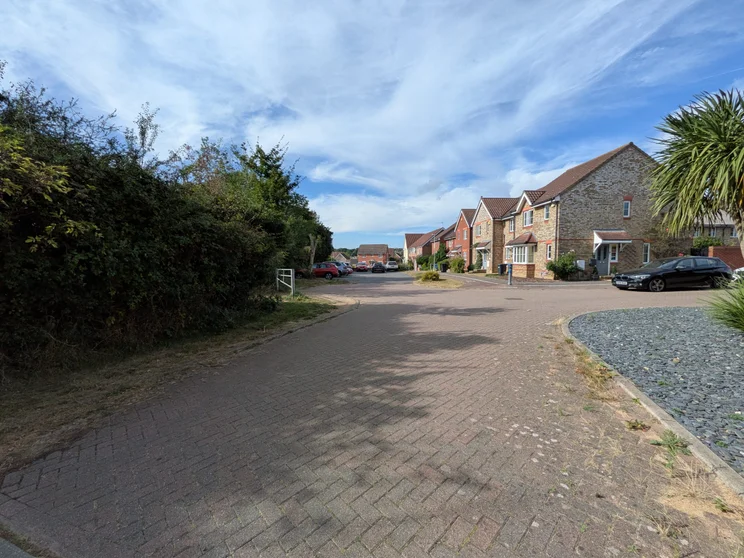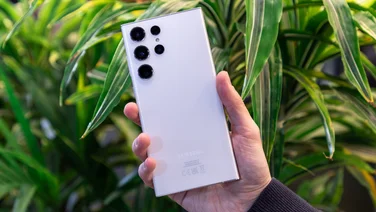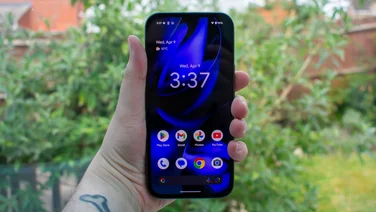To help us provide you with free impartial advice, we may earn a commission if you buy through links on our site. Learn more
- We test more than 50 smartphones and tablets every year, putting each of them through the same thorough testing process.
- The Google Pixel 10 is a big improvement over the previous generation, adding Pixelsnap magnetic charging and a new 5x telephoto camera.
- The 6.3in Actua display performed fantastically in our testing, with particularly strong peak brightness and colour accuracy.
- Battery life proved to be a concern, with the Pixel 10 falling short of the Pixel 9’s result in our standard looping video battery test.
- Google’s Gemini is the most effective and useful smartphone AI, and the Pixel 10 gets new features like Magic Cue and Camera Coach.
- Excellent new telephoto camera
- Qi2 magnetic wireless charging
- Incredible display, as ever
- Performance still behind the curve
- Weaker battery life
- Dropped Wi-Fi 7 support
The Google Pixel 10 marks something of a landmark for the search giant. Google’s flagship smartphone series has hit double figures – and such a milestone deserves celebration. In this case, Google has made the leap to finally fit its non-Pro flagship with its own telephoto camera. And in doing so, it delivers the best upgrade we’ve seen from a Pixel in years.
Along with the new shooter, the Pixel 10 gets the expected processor upgrade, a larger battery and Qi2 magnetic wireless charging via the new Pixelsnap feature. For a grizzled and cynical journalist who is far too used to seeing bare-minimum yearly updates, that’s quite a substantial generational leap.
It would have been nice to see more effort put into making the Tensor chipset competitive with the performance we see from rivals, and battery life is potentially weaker than last year, but overall, the Pixel 10 feels like a worthwhile upgrade. And by keeping the price the same, it offers some of the best value we’ve seen from Google in a good long while.
Google Pixel 10: What you need to know
The new telephoto camera is a 10.8-megapixel sensor that can achieve a 5x optical zoom. The other lenses have been slightly downgraded to compensate for this addition: the main camera is now a 48-megapixel sensor, instead of 50, and the ultrawide drops even more substantially, from 48 megapixels to 13. The 10.5-megapixel selfie camera is unchanged from last year, however.
The display itself is mostly the same, too. It’s again a 6.3in OLED panel with a resolution of 2,424 x 1,080 and a refresh rate that can adjust between 60Hz and 120Hz. The only difference here is that it’s said to have a higher peak brightness than last year (3,000 nits compared to 2,700).
Inside, we have the new Google Tensor G5 chipset running the show, backed up by 12GB of RAM and either 128GB or 256GB of storage. The battery is a slightly larger 4,970mAh cell and wired charging speeds are marginally faster, now at 30W. And, of course, Pixelsnap now allows you to snap your Pixel (ohhhhh, I get it) magnetically onto compatible Qi2 chargers, just like Apple’s MagSafe, for 15W wireless charging.
Price and competition
After consecutively bumping the price up for the previous two generations, Google appears to have finally landed on a price that it’s happy with – for now, at least. The Pixel 10 starts at the same £799 as last year. That gets you the 128GB model, while the 256GB is £899.
With the telephoto now in play, that puts the Pixel 10 head-to-head with the Samsung Galaxy S25, which also starts at £799. This only has a 3x optical zoom lens and a smaller battery than the Pixel 10 but it’s far more powerful, thanks to the Snapdragon 8 Elite chipset, and is both thinner and lighter, making it a more appealing compact flagship.
Until the iPhone 17 series launches in a couple of weeks, the other main competitor is last year’s iPhone 16. Once again, this starts at £799 for the 128GB model and has the Google beat on raw performance – but battery life isn’t as impressive and it lacks a telephoto camera completely.
Finally, the shadow looming over all three is the OnePlus 13, which is the best-value flagship phone around right now. It costs a little more, at £899, but gets you Snapdragon 8 Elite performance, a larger 6.82in display and a 50-megapixel 3x telephoto.
Design and key features
Aside from squeezing in an extra lens on the rear camera bar, the design of the Google Pixel 10 is identical to the Pixel 9, measuring the same 72 x 8.6 x 153mm (WDH). It weighs a little more (204g vs 198g) but that’s pretty understandable given the multiple additions.
It’s just as robust as last year, too, with a strong aluminium frame, IP68 dust and water resistance, a sturdy aluminium frame and a layer of Gorilla Glass Victus 2 over both the display and the rear.
I’m still not sold on the camera bar redesign, and I’d have preferred if the rear wasn’t so glossy – the matte finish on the Pro models is much better at hiding fingerprints – but otherwise, it’s a solid look. You’ve got four colours to choose from this year: my review unit came in the classic Obsidian but there’s also Frost, Lemongrass and my favourite, the richly vibrant Indigo.
On the connectivity front, we see Bluetooth support upped from 5.4 to 6.0 – which is great – but the Pixel 10 only supports up to Wi-Fi 6E this year, whereas the Pixel 9 supported Wi-Fi 7. This has likely been done to better differentiate between the Pixel 10 and Pixel 10 Pro now that both have telephoto cameras but it’s still disappointing when last year’s model has better connectivity options.
The lack of Wi-Fi 7 support also hurts the future-proofing of the Pixel 10, which is a shame because it’s otherwise set to stay relevant for many years to come. It launches with Android 16 and, just like all Pixel phones, is set to receive seven years of OS updates, feature drops and security patches. That’s the same commitment that Samsung and Honor offer for their flagships, and the most extensive software support that you can get from Android.
You get the same loadout of AI tools that we saw last year, with a couple of notable new additions. Magic Cue is a context-sensitive feature that will recognise a scenario – someone asking when your flight lands, for example – and draw up the relevant information from your calendar, screenshots, albums and more, without you having to switch apps. If that sounds a little invasive… it kinda is. But Google says that all of your data is treated confidentially and swiftly deleted once it’s no longer needed. Plus you can always turn the feature off.
There’s also “Camera Coach” for the less confident photographers out there. This recognises what’s in your viewfinder and suggests framing, lens choices and more to help you achieve the perfect snap. Once again, this feels like it takes some of the soul out of photography but it’s an optional extra, so I don’t mind it too much.
Display
As advertised, the 6.3in OLED display does indeed get brighter than last year. On manual brightness, I measured a peak of 1,305cd/m2, while switching to adaptive brightness and shining a torch on the light sensor pushed it up to 1,493cd/m2. Best of all was when displaying HDR content, however, where I recorded a fantastic result of 1,820cd/m2.
Colours are as excellent as expected, too. I spent most of my testing time on the Adaptive profile, as its higher saturation really makes streaming and gaming content pop, but you can get fantastically accurate colours with the Natural profile. Here, I recorded an sRGB gamut coverage of 98.9% and a volume of 100.8%, with the average Delta E colour variance score coming back at just 0.83 – anything under 1 is essentially dead on.
Performance and battery life
As I’ve already mentioned, the one area in which Pixels consistently fall short of the competition is the performance. The 3.78GHz Tensor G5 chipset isn’t about to change that status quo, but it does at least offer a solid improvement over the CPU speeds of the Pixel 9.
In the Geekbench 6 tests, the Pixel 10 produced results that were 33% better than its predecessor in the single-core benchmarks and 38% in the multi-core. Both Samsung and Apple are far out in front, however; in the multi-core test, the Galaxy S25 and iPhone 16 surpassed the Pixel 10 by 59% and 47%, respectively.
Interestingly, we don’t see the same kind of generational improvement on the gaming side of things. In fact, the Pixel 10 performed a little worse than its predecessor in the on-screen results, despite using basically the same display.
It’s still a solid enough gamer, running Asphalt Legends smoothly and without lag, but if you’re serious about intensive mobile gaming, there’s a clear winner in the compact flagship stakes: pick a Samsung Galaxy S25.
Taken at face value, the results of my battery testing are bad. But they’re suspiciously bad – I find it hard to believe that the new Pixel 10, with its larger 4,970mAh battery, would last for four hours less than its predecessor.
I saw even more egregiously plummeting stamina on the Pixel 10 Pro and Pixel 10 Pro XL, which suggests to me that there is potentially some kind of software bug that is excessively draining the battery on my review units. I’ll be redoing the battery tests on all three as soon as a new software patch comes through, so I’ll update this review with the final verdict once I get the results.
For now, the Pixel 10 lasted for 22hrs 45mins, which is worse than the entire Pixel 9 series, including the Pixel 9a, as well as the entire Pixel 8 and Pixel 8a. Moreover, it’s worse than the Galaxy S25 and iPhone 16, as well as near-enough every other flagship from this year.
It’s worth highlighting that our looping video test is a general guideline of stamina that allows us to accurately compare between different models, rather than a strict benchmark. In day-to-day use, the Pixel 10’s battery doesn’t drain excessively quickly – you’ll easily reach bedtime with moderate screentime if you’re already in the habit of charging every night – it’s just disappointing to see such a generational dip.
The addition of Pixelsnap is a great progression for Pixel phones – Apple has had MagSafe on iPhones for around five years now, so an Android alternative was long overdue. In addition to the standard puck charger, Google is releasing a charging stand and a ring stand, and the official cases have magnets too, so you can still use the accessories while protecting your Pixel.
Cameras
The telephoto camera is the new kid in town, so let’s start there. The 10.8-megapixel sensor isn’t going to get you the same kind of detail that you get on the Pros – so there’s not much danger of the Pixel 10 eating into its bigger siblings’ market share – but it still manages to produce some gorgeous zoom shots with crisp definition and lovely colours.

With the addition of the telephoto camera, the Pixel 10 can now zoom up to 20x – where the Pixel 9 tapped out at just 8x. Images feel heavily processed at the full 20x but you can get some solid shots at 10x, at least:

As for the main camera, losing a couple of megapixels didn’t hurt. It still has plenty of quality behind it, with a wide f/1.7 aperture, optical image support (OIS) and dual pixel phase detection autofocus (PDAF), and the results are just as good as last year.
Shots captured in good lighting are crisp and well exposed, with broad dynamic range and natural colouring.

Things continue to look fantastic after dark, too. The artificial brightening plucks plenty of detail from the darker areas, the sky is relatively clear of visual noise and bloom from light sources like lampposts is managed well.

Unsurprisingly, you feel the lower pixel count with the 13-megapixel (f/2.0) ultra-wide camera. Detail isn’t as strong as the sharper lens on the Pixel 9, particularly towards the edges, but otherwise, the images produced are nice and bright and the colour tone broadly matches shots from the main camera, too.

Rounding out the collection are the same 10.5-megapixel selfie camera as last year, and a video suite that once again shoots up to 4K/60fps natively, with the Video Boost setting giving you the option to have footage upscaled to 8K/30fps via cloud processing.
Google Pixel 10: Verdict
Assuming the battery life isn’t some kind of glitch and that’s the results we’re working with, stamina is the biggest downfall here. It’s not aggressively bad, and shouldn’t drastically affect those who religiously charge overnight, but it’s still quite a ways behind the competition. Add the weaker performance into the mix, and it’s clear that the Pixel 10 is nowhere near as good a compact flagship as the Samsung Galaxy S25.
With that being said, there’s still a lot to like here that even the poor battery life can’t undermine. The addition of Pixelsnap is a huge leap for Android users, the new telephoto camera is a decent shooter, Gemini continues to be the most robust and effective smartphone AI package on the market and the display is just as beautiful as ever.
It’s not as big of a statement as I would have liked to see for Google’s first double-digits flagship, but of this latest batch, the Google Pixel 10 offers the best value for money by far.






